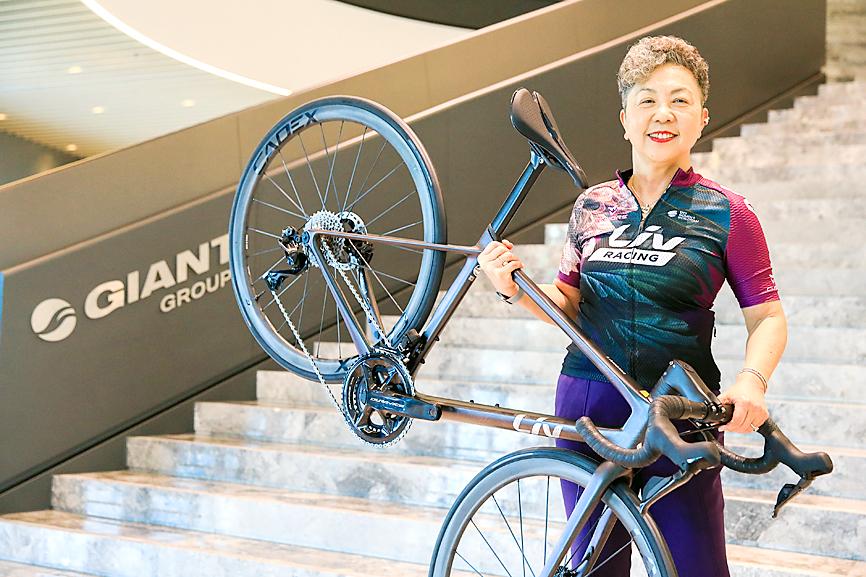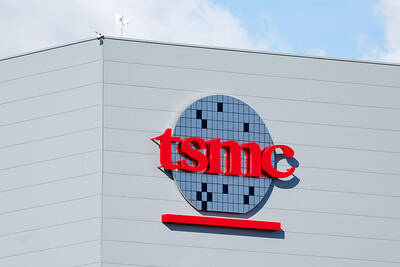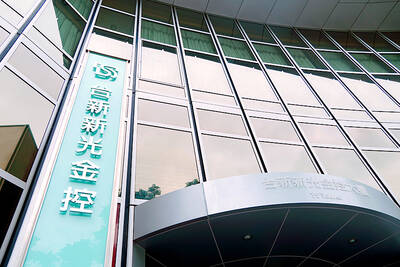Giant Manufacturing Co (巨大機械) is waiting as long as two years for bicycle parts as unprecedented disruptions and lockdowns roil the global supply chain, putting one of the world’s biggest bike makers at risk of missing out on a demand boom.
“It is a hell of job,” Giant chairperson Bonnie Tu (杜綉珍) said in an interview at the company’s Taichung headquarters.
Some bicycle parts have a lead time of two years and even simple components can take six months, she said. That compares with a normal wait time of one to two months.

Photo: Cheng I-hwa, Bloomberg
The global supply chain has been plagued by chaos for more than two years, as sudden shortages, shipping delays and soaring prices hit everything from masks to vehicles and iPhones. Russia’s invasion of Ukraine and China’s hard-line approach to stamping out its worst COVID-19 outbreak in two years has further exacerbated the problems, boosting the risk of a global recession.
Giant has temporarily shut four plants in Kunshan, which borders Shanghai, to comply with local lockdown measures.
The restrictions have also meant components cannot be brought in, Tu said.
The company has five manufacturing centers in China, which account for about 3.5 million bikes — more than half its total capacity.
The disruption has underscored the importance of diversifying sourcing and production locations.
“We understand we can’t put all our eggs in one basket,” Tu said, and Giant is joining many other manufacturers in shifting to producing more goods locally.
The company also has one plant in Taiwan, the Netherlands and Hungary. Giant plans to start production at its new factory in Vietnam by the end of the year, benefiting from the country’s free-trade agreement with the EU, which accounts for almost 40 percent of Giant’s sales.
Competitors have shifted their supply chains away from China to Cambodia, which has zero export duties on goods sent to the US, Tu said.
There are tentative signs that the worst of the supply crunch is easing. Bike inventory has rebounded to about four weeks of demand from almost zero last year, although it is still lower than the normal level of eight weeks, Tu said.
High-end bicycles face the worst shortages of parts, but Tu predicted that is likely to ease by the end of this year.
Some components, like the Shimano Inc derailleur set that is a core part of a bike’s gear mechanism, might still be in short supply into next year.
Tu estimated that Giant would post a high-single digit to low-teens revenue growth this year, after reporting a record NT$81.8 billion (US$2.81 billion) in sales last year, in part due to rising demand for electric bikes.
The sector might account for 40 percent of Giant’s total sales in three years, compared with 31 percent last year.
Still, Tu warned that the company’s outlook would depend on supply conditions, particularly in China.
“No one knows what the China government will do” with its zero COVID-19 policy, Tu said, adding that measures to allow workers to live at factories during lockdown periods would help ease disruptions.

Taiwan Semiconductor Manufacturing Co (TSMC, 台積電) secured a record 70.2 percent share of the global foundry business in the second quarter, up from 67.6 percent the previous quarter, and continued widening its lead over second-placed Samsung Electronics Co, TrendForce Corp (集邦科技) said on Monday. TSMC posted US$30.24 billion in sales in the April-to-June period, up 18.5 percent from the previous quarter, driven by major smartphone customers entering their ramp-up cycle and robust demand for artificial intelligence chips, laptops and PCs, which boosted wafer shipments and average selling prices, TrendForce said in a report. Samsung’s sales also grew in the second quarter, up

On Tuesday, US President Donald Trump weighed in on a pressing national issue: The rebranding of a restaurant chain. Last week, Cracker Barrel, a Tennessee company whose nationwide locations lean heavily on a cozy, old-timey aesthetic — “rocking chairs on the porch, a warm fire in the hearth, peg games on the table” — announced it was updating its logo. Uncle Herschel, the man who once appeared next to the letters with a barrel, was gone. It sparked ire on the right, with Donald Trump Jr leading a charge against the rebranding: “WTF is wrong with Cracker Barrel?!” Later, Trump Sr weighed

HEADWINDS: Upfront investment is unavoidable in the merger, but cost savings would materialize over time, TS Financial Holding Co president Welch Lin said TS Financial Holding Co (台新新光金控) said it would take about two years before the benefits of its merger with Shin Kong Financial Holding Co (新光金控) become evident, as the group prioritizes the consolidation of its major subsidiaries. “The group’s priority is to complete the consolidation of different subsidiaries,” Welch Lin (林維俊), president of the nation’s fourth-largest financial conglomerate by assets, told reporters during its first earnings briefing since the merger took effect on July 24. The asset management units are scheduled to merge in November, followed by life insurance in January next year and securities operations in April, Lin said. Banking integration,

LOOPHOLES: The move is to end a break that was aiding foreign producers without any similar benefit for US manufacturers, the US Department of Commerce said US President Donald Trump’s administration would make it harder for Samsung Electronics Co and SK Hynix Inc to ship critical equipment to their chipmaking operations in China, dealing a potential blow to the companies’ production in the world’s largest semiconductor market. The US Department of Commerce in a notice published on Friday said that it was revoking waivers for Samsung and SK Hynix to use US technologies in their Chinese operations. The companies had been operating in China under regulations that allow them to import chipmaking equipment without applying for a new license each time. The move would revise what is known